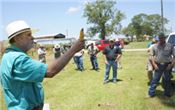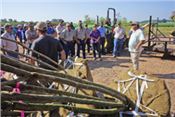|
Louisiana Crops Highlight Field Tour For Government Agency Representatives
BUNKIE, LA.
State and federal agency representatives attended a crops tour held by the LSU AgCenter on July 25 to give them idea of the agricultural diversity in central Louisiana.
The tour started near Bunkie at the James Deshotel sweet potato farm followed by a stop at the Todd Steele tree nursery. The tour then traveled to the Charlie Fontenot farm near Lebeau to hear about rice farming, stopped at the Lowrey cattle operation and ended near Melville at the Cannatella farm to get an overview of sugarcane farming.
Tara Smith, director of the AgCenter Central Region, said the tour helps build the relationship between the AgCenter and agricultural agencies. “The goal is the interagency cooperation opportunity, but the biggest goal is the training of the agency employees to help them understand issues faced by stakeholders,” she said.
Agencies attending the event included several sections of the Louisiana Department of Agriculture and Forestry, and the U.S. Department of Agriculture Farm Services Administration and USDA Natural Resources Conservation Service.
Kevin Wofford, LDAF director of pesticide and environmental programs, said the event has been held for several years, and it is beneficial for LDAF employees from across Louisiana to learn about the different agricultural operations in the state. “It’s gaining momentum, and it gets better every year,” he said.
At the first stop, Deshotel talked about the challenges of growing and selling sweet potatoes. He said the sweet potato business in south Louisiana almost shut down because of a quarantine imposed to prevent the spread of the sweet potato weevil, but the rule was amended to allow washed potatoes from south Louisiana to be shipped to a processor in north Louisiana.
At the Steele tree farm, Steele said he ships plants as far away as Washington state and Maryland.
AgCenter commercial horticulture specialist Jeb Fields said Louisiana has become 15th in the U.S. for volume in the nursery industry. “It’s a big, growing industry,” he said.
At the Fontenot farm, Vince Deshotel, AgCenter agent in St. Landry Parish, said the 7,000-acre operation has the advantage of good soil. “It’s probably as good as any in the U.S.,” he said.
Chris Davis, NRCS agent in St. Landry Parish, said Fontenot is his best conservation advocate.
AgCenter rice specialist Dustin Harrell described his research to develop agronomic guidelines for new varieties. He also talked about the growing trend of row rice, or furrow-irrigated rice.
AgCenter rice breeder Adam Famoso talked about the steps involved in developing a new rice variety.
AgCenter soybean specialist Boyd Padgett talked about his off-station trials. Padgett said flooding rains from Hurricane Barry caused considerable damage to soybeans in some areas. “We will not know the entire impact on the beans until we drop the combines into the fields,” he said.
At the Lowrey farm, AgCenter weed scientist Ron Strahan discussed control of Virginia buttonweed and smutgrass.
Scott Perry and Jesse Bellard, both of the LDAF Brand Enforcement Office, said prosecuting a case of cattle theft requires traceability of an animal to its original owner.
Bellard said taking regular photos of a herd provides some good identification, and brands also help determine ownership.
Perry said radio frequency identification tags will be required by 2023 for animals moved across state lines.
At the Cannatella farm, AgCenter corn specialist Dan Fromme said he had corn studies at 14 locations throughout the state, including the Cannatella farm. He would have had more locations but weather prevented planting in some areas.
Vince Cannatella said sugarcane has been grown at the farm for the past four years. “It’s been a good experience for us,” he said.
Vince Deshotel said St. Landry Parish had 7,000 acres of cane a few years ago, but that amount has more than tripled.
Randy Fontenot of the FSA said St. Landry Parish soybean acreage for 2019 is at 84,000, a decrease of 15,000 from last year.
He said rice declined by 1,600 acres for a total of 24,460 this year.
AgCenter pest management specialist Al Orgeron said sugarcane is one of the state’s oldest crops. The cost of planting is the biggest expense of a sugarcane crop.
Atticus Finger, plant breeder for the American Sugar Cane League, said experimental plots of cane will be planted this year at the AgCenter Dean Lee Research Station near Alexandria to help provide information on variety cold-tolerance traits for growers in central Louisiana.
Wofford gave an update on pesticide drift complaints. Last year, 38 complaints received involved the use of dicamba. “This year, we have three,” he said.
LDAF will sponsor a disposal program for unwanted pesticides in the fall. ∆

LSU AgCenter corn specialist Dan Fromme tells how adverse weather can affect grain
formation in an ear of corn at the Cannatella Farm near Melville, Louisiana.
Photo by Bruce Schultz/LSU AgCenter

LSU AgCenter rice breeder Adam Famoso, far right, talks about the process of developing a new rice variety. He
spoke at a recent crops tour held by the LSU AgCenter for state and federal agricultural agencies.
Photo by Bruce Schultz/LSU AgCenter

Todd Steele, far right, explains how trees are harvested at the Louisiana Tree Farm in Bunkie for sales throughout the U.S.
Photo by Bruce Schultz/LSU AgCenter
|
|